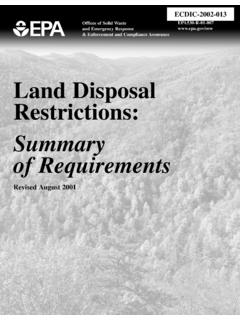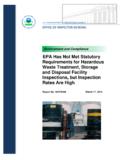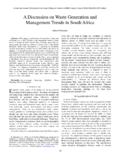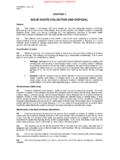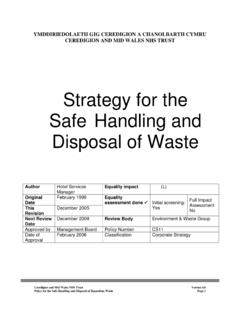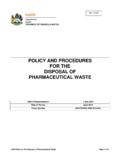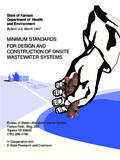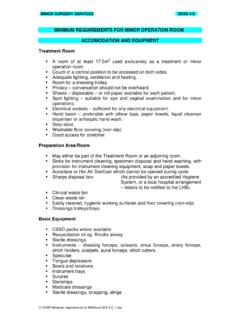Transcription of Guidance for Implementing and Documenting …
1 CONNECTICUT DEPARTMENT OF ENERGY & ENVIRONMENTAL PROTECTION Bureau of Materials Management and Compliance Assurance waste Engineering and Enforcement Division 79 Elm Street, Hartford, CT 06106 5127 Guidance FOR Implementing AND Documenting CLOSURE ( waste REMOVAL AND DECONTAMINATION) FOR INDOOR RCRA HAZARDOUS waste CONTAINER STORAGE AREAS MAY 1, 2013 Guidance for Implementing and Documenting Closure ( waste Removal and Decontamination) for Indoor RCRA Hazardous waste Container Storage Areas May 1, 2013 Page 2 TABLE OF CONTENTS SECTION PAGE No. (1) INTRODUCTION .. 3 (2) IMPLEMENTATION .. 4 (a) waste Removal .. 4 (b) Area Inspection .. 4 (c) Records Review.
2 4 (d) Decontamination .. 4 (i) Final Rinse/Wash .. 5 (ii) Equipment used in Decontamination .. 5 (iii) Decontamination Residues .. 5 (iv) Additional Hazard Minimization .. 5 (e) Closure Derived waste Storage and Disposal .. 5 (f) Confirmatory Recommendations .. 6 (3) ADDITIONAL Guidance .. 6 (a) Constituents of Concern List Development .. 6 (b) Sampling and Analysis .. 7 (4) DOCUMENTATION .. 7 Pre accumulation .. 7 Pre closure .. 7 Post closure .. 7 Closure Documentation .. 7 waste Removal Records .. 7 Area Inspection Confirmation.
3 7 Records Review .. 7 Decontamination Process .. 8 Closure Derived waste Management .. 8 Closure Performance Standard Confirmation .. 8 Records Retention .. 8 (5) ATTACHMENTS Attachment A, Examples of Decontamination Methods .. 9 Attachment B, Example of Basic Closure Documentation .. 10 Attachment C, Closure Certification .. 11 Guidance for Implementing and Documenting Closure ( waste Removal and Decontamination) for Indoor RCRA Hazardous waste Container Storage Areas May 1, 2013 Page 3 SELF- Implementing CLOSURE PROCESS (1) INTRODUCTION. This document was developed by the Connecticut Department of Energy & Environmental Protection ( DEEP ) to provide Guidance to generators1 engaging in the self- Implementing process of closing areas used to store hazardous waste pursuant to the Resource Conservation and Recovery Act ( RCRA ).
4 More specifically, this Guidance is intended to address closure of INDOOR HAZARDOUS waste CONTAINER STORAGE AREAS (CSAs) at which: (a) The storage area s secondary containment system has had an impervious base during its life time. For example, application of an epoxy coating at some point after hazardous waste storage began would require closure including the more traditional chip-sampling method; (b) The site operating records demonstrate that no major spills occurred in the storage area. As a clarification, a major spill is an event that cannot be handled safely without the assistance of the emergency response personnel. This Guidance is only applicable to spill resulting from routine management of waste in containers (slight overfills, drips, splashes, etc.)
5 The site operating records ( , inspection logs) must be available for the entire operating life of the CSA; (c) The generator has conducted regular inspections of the CSA and has maintained documentation of such inspections in the operating record for the life of the CSA; (d) The secondary containment system of the CSA being closed shows no visible sign of spills/stains/cracks/deteriorations; and (e) P listed waste was never stored in the CSA. Note: The Closure Performance Standard (40 CFR ) requires closure of hazardous waste storage areas in a manner that minimizes the need for further maintenance, and is protective of human health and the environment. These regulations neither require that a closure plan be submitted for review and approval nor do they specify the steps necessary for closure.
6 To address this gap in the regulations, this document provides best management practices (not regulations) for generators who wish to close a CSA (due to the need to discontinue storing hazardous waste at the specific area, the relocation of a waste storage area within their facility, etc). This Guidance is a companion document to the generator closure Guidance document that is intended to be used for those CSAs that do not meet the above conditions and it is not meant to replace that generator closure document. 1 In cases where a generator exceeds the allowable accumulation time limit, CTDEEP may impose more rigorous closure requirements. These requirements can be found in the Department draft document titled: RCRA Closure Plan Guidance , Container Storage Areas and Tank Systems, latest edition or as revised.
7 Guidance for Implementing and Documenting Closure ( waste Removal and Decontamination) for Indoor RCRA Hazardous waste Container Storage Areas May 1, 2013 Page 4 (2) IMPLEMENTATION. Generators who need to close a hazardous waste storage area that meets the above-listed criteria may perform closure by Implementing the following actions: (a) waste removal. Upon ceasing operation of a storage area, the generator needs to remove all the containerized hazardous waste from the storage area, and ensure that such waste is shipped off-site to a permitted facility. The time allowed for removal and disposal of such waste will depend on your generator status and when waste began accumulating in the storage area.
8 Generally speaking, large quantity generators may store waste in a storage area for up to 90 (ninety) days. Therefore, containers of waste must be removed from the storage area and shipped off-site within 90 (ninety) days from the day the waste first began accumulating in the storage area. Small quantity generators generally have one hundred eighty (180) days to remove and dispose of their waste . Generators should maintain copies of the manifests with their storage area closure records verifying that all the waste was removed from the storage area and was shipped off-site within the applicable time frames. More specific recordkeeping Guidance is provided in the Closure Documentation section of this document. (b) Area Inspection.
9 Once the containerized waste has been removed from the storage area, the generator should remove any loose materials/debris from the secondary containment system using an appropriate method (sweep, shovel, vacuum, etc.) prior to conducting an inspection/evaluation of the area (physical observation) to confirm that: (1) the secondary containment system has an impervious base ( , no cracks and/or deteriorations, adequate coating/sealant, etc.); and (2) there are no visible signs of spills/stains (other than light shadows, slight streaks, or minor discoloration). If any deficiencies are found with the secondary containment system or there are visible signs of spills/stains then this self- Implementing closure Guidance is not recommended. (c) Records Review.
10 Once the area inspection has been completed, the generator should conduct a thorough records review to ensure that: (1) no major spills occurred in the storage area; (2) the generator has conducted at least the required weekly inspections of the storage area (there should be no significant gaps in the required inspection records); and (3) P listed waste was never stored in the storage area. If the records review reveals that the conditions above have not been met, then this self- Implementing closure Guidance is not recommended. (d) Decontamination. If the inspection and records review of the storage area are found to be acceptable, the storage area is ready for the process of decontamination. After considering factors such as materials of construction, potential contaminants, location of the unit and physical observations, select and implement a decontamination method to remove any hazardous waste residues that may be adhering to the containment system and/or associated equipment used to manage hazardous waste .










